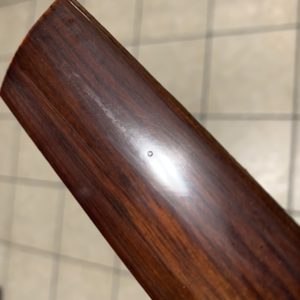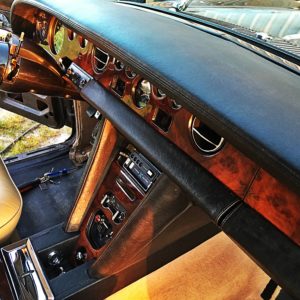Polyester resin on fine automobile veneer
Hello everyone my name is Michael. I’m from Dallas Texas and this is my first post.
I’ve been collecting and restoring cars since I was 16. Over the last three years, I’ve been getting into restoring more high-end vehicles like classic Rolls-Royce. I can restore just about anything on a car, but wood trim was something I always avoided and sent out, until this past year.
I’ve become quite good at stripping off old nitrocellulose lacquer and prepping wood trim for recoating, but I continue to struggle with fisheye and pinholes in my coatings despite everything I’ve tried. I would like to explain my process so that maybe one of you can guide me on how to avoid this incredibly time-consuming and destructive issue I continue to have.
I am using 2 products, both polyester resin-based and manufactured by Simtec In California. One is a sandable sealer and the other is a flexible clear.
my process is as follows (using nitrile gloves):
strip workpiece to veneer
lightly sand veneer with 320
prep workpiece for sealer coating using grease and wax pre-prep
move workpieces into the paint booth
lightly skim workpiece with a tack cloth
prepare resin and mekp catalyst
mix resin
pour into strainer attaches to hvlp gun with 2.5 mm tip
Apply a tack coat to the workpiece
wait a few minutes
spray medium wet coat
wait 15 minutes
spray medium wet coat
let dry overnight
Sand with 300
repeat process with flex clear
Dry overnight
flatten with 600
followed by 1000
machine polish
I know that’s a lot but I thought it was important to share what I’ve been doing. Now the issues that I run into every single time, The sealer and flex always develop fish eyes.
I’ve tried everything I know to do, I have adjusted the gun until I’m blue in the face, I’ve adjusted my fan patterns, the distance from the workpiece.
in order to combat these fish eyes, I will let the piece dry and go over the fisheye with a small brush with the coating but it almost always causes a visible blemish after sanding flat. In addition, if the fisheye is in the final flex clear and you burn through the clear trying to remove the fisheye, it will leave a visible halo around the area which requires a re-spray or at worst a total strip and rework. I’ve had to rework a few pieces so much, I damaged the veneer.
The final straw was yesterday when I was finishing up a classic Mercedes and two of the pieces were covered with small pinholes and I just had enough. The coating manufacturer is useless and will provide no real support.
It’s to the point now where this particular coating has almost ruined the wood trim on two vehicles and cost me hundreds of hours in rework. I have included a photo of a piece from yesterday where you can clearly see a pinhole (the piece has not been machined polished as I stopped work due to pinhole), along with another photo of a Rolls-Royce I just finished. The Rolls in the photo was brutal and although beautiful, still not to my standards.
I would greatly appreciate any feedback anyone has to offer me.

















Replies
Two things come to mind. First is the preparation with grease and wax, we usually go to great efforts to make the surface free of grease and wax so unless this is recommended by the coatings manufacturer and tailored to your products, I would avoid. Second is the source of fisheyes, usually it is the presence of silicon in the workplace and a third source could be oil from the compressed air source, compressors can leak oil in the air that will translate into pinholes in the finish.
Yeah, the pinhole is a blob is something going through the gun. Fisheye is from silicone, and it could have been from any step in the process.
I'd avoid tack cloths. They could introduce an unwanted chemical into the process. The woodworking precast lacquer I use specifically says to not use a tack cloth.
Ok, so I will try process without tack cloth next time and see if that could be the issue. I am relatively sure that my air system is clean. I use DeVilbiss 130524 Desiccant Cartridges in a DeVilbiss QC3 Filter, which is a 3 stage filter system which they claim has a 0. 1-micron rating that produces clean, oil and humidity-free air. I change the cartridge every 3 months.
Also, I had considered that my physical air hose could be disintegrating internally so I have a dedicated air hose that is only used for coatings and is new.
If you guys are not recommending grease and wax pre-prep, would IPA work or what do you use to ensure no contaminates are on surface before shooting?
Im assuming that you dewax and degreaser, not wax and grease?
I find featured alcohol best for surface cleaning, but don't often need it. I almost always use Zinsser Sealcoat as the first two coats of finish. It seals well, blocks anything that might be in the wood, including natural oils, and I can put any finish I want on top of it.
correct, I do not put wax or grease on the work piece. I will look into Zinsser Sealcoat immediately
“[Deleted]”
To get a dust free surface vacuum and wipe with a solvent and just before spraying, blast the surface with compressed air from you spray gun hose inside the spray booth.
I doubt any of your problems are related to technique if you have no problems with spraying finish on metal. Fisheye is caused by surface tension issues between the underlying material and the finish. Pinholes can also be caused by the same issue. I suspect there is something in the previous finish which causes the problem. Shellac is the secret weapon used in wood finishing to separate two problem layers. Zinsser Sealcoat is shellac and can be sprayed, brushed, or rubbed on. It should be fine under your finishes, but test it first. You can dilute the cut to keep the layer thin. Shellac is hard and will have less flex than your other finishes, but will likely be fine for a restored vehicle, they tend to see less use and less sun damage.
If the shellac won't work, you will likely have to find a different finish with a different chemical base.
This forum post is now archived. Commenting has been disabled